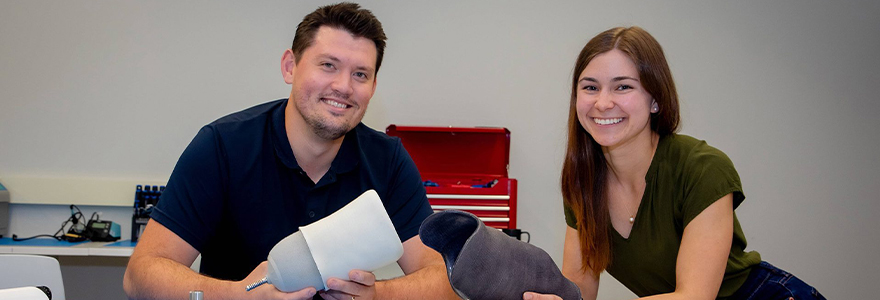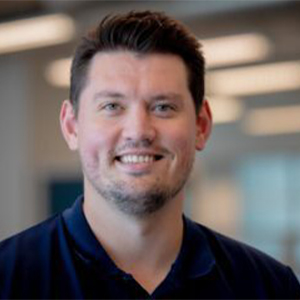Medical Innovation Fellowship team creates adjustable socket to increase amputees’ comfort

Oleksiy Zaika, MSC'15, PhD'23 and Sydney Robinson, MESc'21, founded Vessl Prosthetics Inc. after meeting in the Medical Innovation Fellowships program offered by WORLDiscoveries at Western. (Christopher Kindratsky/Western Communications)
By Keri Ferguson, Special to Schulich Medicine & Dentistry Communications
From the moment they met, business partners Sydney Robinson and Oleksiy Zaika clicked.
Two years later, they’re making a perfect fit as creators of an automatically adjustable prosthetic socket and cofounders of Vessl Prosthetics Inc.
Working closely with prosthetists and their patients, their vision is to help lower limb amputees experience less pain and an increased quality of life.
From student project to viable startup
“Oleksiy and I loved working together from day one,” Robinson, MESc’21, said, noting the blend of their opposite skillsets being key to taking their company forward.
“I’m a bit of a jump the gun person, and Oleksiy will help slow me down, making sure we have all the right information to make the best decisions. On the flip side, when he’s wavering or hesitating on that ‘last 10 per cent,’ I’m good to execute,” she said.
Robinson met Zaika, MSC’15, PhD’23, who recently received his PhD from the Department of Anatomy and Cell Biology at Schulich Medicine & Dentistry, on their first day of bootcamp in the Western Medical Innovation Fellowship (MIF) program, offered through WORLDiscoveries. As selected participants for the highly competitive program – the first of its kind in Canada – they were part of a talented group of young scientists and engineers immersed in clinical environments to identify unmet clinical needs.
 Vessl Prosthetics Inc. CEO Sydney Robinson (Christopher Kindratsky/Western Communications)
Vessl Prosthetics Inc. CEO Sydney Robinson (Christopher Kindratsky/Western Communications)
Their team was assigned to observe a diabetes clinic in Hamilton, Ont. It’s where they first learned diabetes is the leading cause of leg amputation and that amputees who use prostheses share a common concern: Poor socket fit.
The socket is a cup-like adapter connecting the limb to the prosthetic device. As the limb shrinks and swells throughout the day, socket fit is compromised, leading to chafing and blisters. The pain forces many amputees to abandon their prosthesis. With the loss of mobility, comes a decline in quality of life.
“We met a lot of amputees who were all struggling with their socket not fitting because their leg would fluctuate in size throughout their day,” Robinson said. “This seemed like an archaic problem. We first thought surely someone had come up with something better than this. But the research shows they haven’t found a solution that’s widely accessible and clinically feasible. It’s an underserved – and under-researched – population. There are a lot of really qualified experts in the research area of prosthetics, but it’s only just picking up momentum. It doesn’t have the history of research like other fields do.”
Addressing poor socket fit in amputees
Currently, amputees rely on prosthetic socks to make up the volume they lose in their leg throughout the day. It wasn’t uncommon for Robinson and Zaika to hear from patients who use up to 10 socks throughout their day.
“In a single day, their limb can fluctuate 10 per cent in volume. A change of a mere one per cent can cause them to feel a difference in fit,” Zaika said. “One gentleman we spoke with puts his prosthetic on, drives to work and, before leaving his car, has to put another sock on. The volume can drop and fluctuate that quickly. He has to hike up his pants, take time out of his day to do this. These socks take up space. He works on his feet, so he has to add socks before he starts his shift, because he might not have a chance to pause later on.”
 Vessl Prosthetics Inc. COO Oleksiy Zaika (Christopher Kindratsky/Western Communications)
Vessl Prosthetics Inc. COO Oleksiy Zaika (Christopher Kindratsky/Western Communications)
Similar stories drove the Vessl team to develop a unique socket that adjusts automatically, distributing pressure around the limb as it shrinks and swells.
Their innovation attracted early interest and support. By the time they graduated from the fellowship program last June, they’d made their first pitch, winning $25,000 at the 2022 MSK Innovation Competition hosted by Western’s Bone and Joint Institute and the Morrissette Institute for Entrepreneurship.
They’ve since been accepted into the Velocity venture-ready program at the University of Waterloo, the Western accelerator program and are currently housed at the BioNext incubator at Robarts Research Institute.
Vessl most recently attracted financial support and expert advice through the Idea Fund, a strategic initiative offered through London, Ont.’s TechAlliance. The initiative also offers mentorship and networking opportunities.
Focused on the problem, not the solution
The team has worked fast, developing four different models before landing on ones specifically created for a group of amputees who will provide valuable feedback. They are also working with engineering professor Emily Lalone, whose team is conducting studies, testing the socket.
“The things we were ideating and creating towards the end of the fellowship are worlds apart from the solutions we have now,” Zaika said. “We’ve completely scratched things, started over multiple times.
“We have a big advantage coming to this problem from the outside, through a pure scientific mindset, asking what efficiency can be made, what kind of problems can we solve? Then, by diving into it, we were gutted by these problems we saw and then developed an intense passion for it.”
Robinson added their “married to the solution, not the problem” approach helps keep them moving.
“We don’t care how we’re going to solve the problem. If this design doesn’t work, that’s fine, we’ll just start again,” she said. “Sometimes people develop something for so long, it becomes their baby and if it doesn’t fit that problem, they’re going to make it fit ‘some problem,’ whereas we keep the focus on the problem itself.”
MIF program director Sarah Hutchison has watched Robinson and Zaika’s entrepreneurial journey evolve, with WORLDiscoveries also playing a crucial role in helping the former fellows bridge the gap between academia and industry, providing them access to market research, industry connections and intellectual property.
“It is extraordinary what Oleksiy and Sydney have accomplished in such a short time,” Hutchison said. “Their commitment to their product, their company and to the people who have a lower limb amputation is remarkable. They personify how certain combinations of people ignite innovation and an entrepreneurial spark – and have a passion and affinity to work together to make great things happen.”
They also took their time to fall into their respective roles naturally, with Robinson as CEO, focusing on investor and clinical relations and Zaika, as COO, creating and iterating designs.
With a leg amputated every 30 seconds worldwide, they share a desire to make an impact globally, including in Zaika’s homeland, Ukraine.
“I would love to find avenues for us to get funding to bring these systems to Ukraine and to help people. I don’t know when things will be normal again for the country, but I would love to help the individuals feel a bit of normalcy, even if it is just for their limb health. The war has caused a huge spike in amputations and loss of limbs, and those people deserve to have their lives back.”









